If you decide to sell on Amazon, the sales rank of each product is a very important piece of information that you can use to improve your product sourcing.
The Amazon Sales Rank is a numerical rank of all products in the same category, where a lower number means a product is currently selling better and more often than a product with a higher number. Sales rank #1 is the best spot a product can have. This information is available for both top-level categories (like Toys & Games) and subcategories (like Toys & Games > Puzzles).
In this post, we’ll talk about the right ways you can use the BSR in your business and the mistakes many people make with it. This will be an in-depth look at the Amazon Sales Rank that will answer questions like:
- What is the Amazon Sales Rank?
- How Is The Amazon Sales Rank Calculated?
- How Do I Find the Sales Rank of a Product on Amazon?
- How Do I Use The Amazon Sales Rank?
What is the Amazon Sales Rank?
The sales rank is a piece of data supplied by Amazon that shows how strongly a product is selling compared to other items in the same category.
The lower the number a product’s sales rank is, the better it is currently selling compared to other items in that same category. A sales rank of #1 is better than #10. A sales rank of #10 is better than #1000.
Here is what Amazon has to say about the number:

Sales Rank vs Best Sellers Rank vs Rank vs BSR
One thing to make clear upfront is that there are multiple terms that sellers use that all refer to the same thing. So sales rank, best sellers rank, BSR, and rank in the context of selling on Amazon can all be used interchangeably.
If you ever come across an acronym related to selling online that you aren’t familiar with you can likely find it in the Ultimate Amazon Acronyms Glossary, which is a free resource here on this site.
How is the Amazon Sales Rank Calculated?
The exact formula Amazon uses to calculate the sales rank of an item isn’t shared with the public, but we do know that it is a function of both sales recency and the total number of units sold.
So having 100 sales is better than having 10 sales, and having a sale in the last minute is better than not having one since last week.
Those are very simple examples though, and they still leave a lot of questions. For example, what is more important, recency or total sales?
To answer that, the best we can do is look at the current sales rank list and make some inferences.
As I am writing this, here are the items with the top three sales ranks in the Toys & Games category on Amazon:
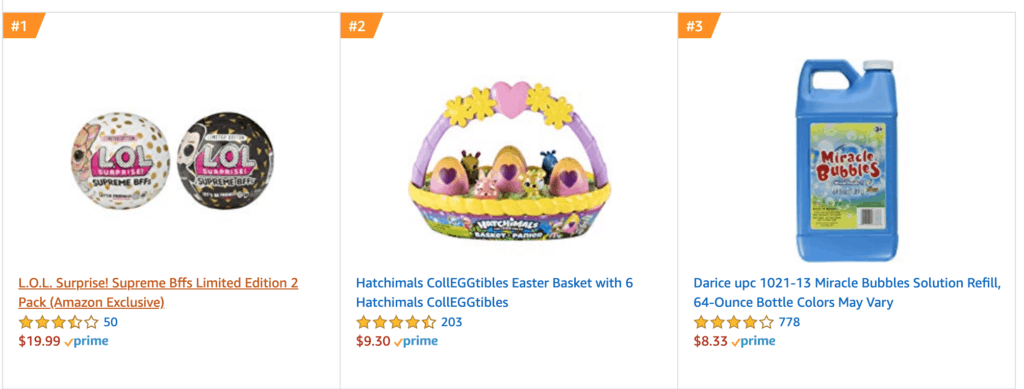
Seeing L.O.L. Surprise in the top spot doesn’t tell us very much. Anything with that brand has been a regular for the last couple of years. But the next item, a Hatchimals CollEGGtibles Easter Basket does tell us a lot.
That is a product that has very limited demand outside a very small window of time (the weeks leading up to Easter). We can reasonably assume that it has nowhere near the total amount of sales as the currently #7 ranked Cards Against Humanity, but that a higher volume of recent sales has propelled it to the #2 spot.
This means that the more recent a sale, the more value it is given in the sales rank calculation. Sales farther in the past are still credited towards an items sales rank, just not as much as those that have happened more recently.
How often is the sales rank updated?
Amazon updates the sales rank lists every hour.
The fact that they update the list so often is another indication of how important recency is in their calculation.
How to Find the Sales Rank of An Item on Amazon
If you are interested in seeing what items are at the top of the sales rank lists, you can go to Amazon’s Best Sellers page and look through the best selling products for every category.
That page looks like this:
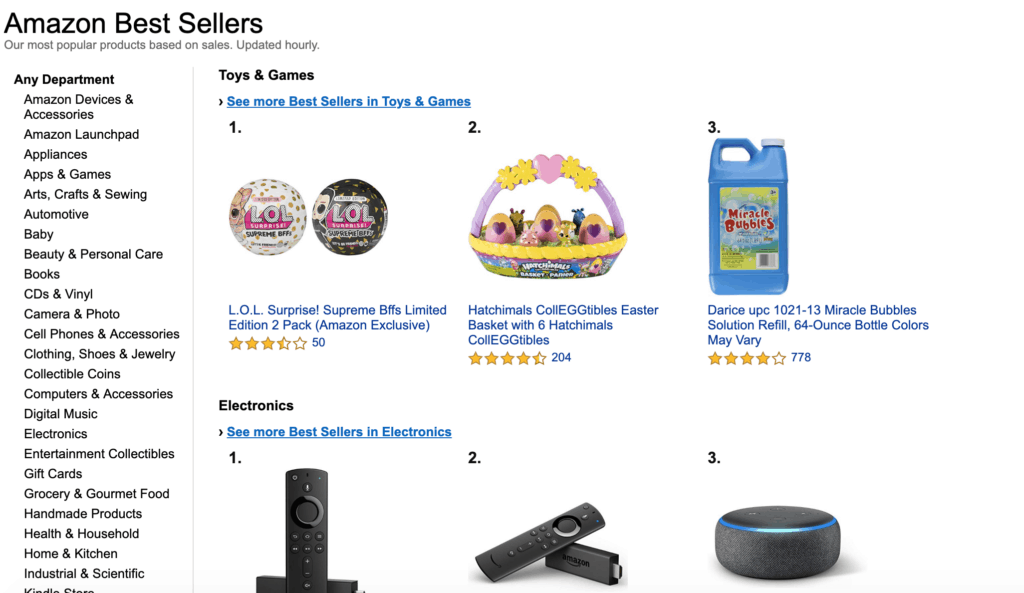
Note that once you open the list for a specific category, you can then filter down based on some of the higher-level subcategories:
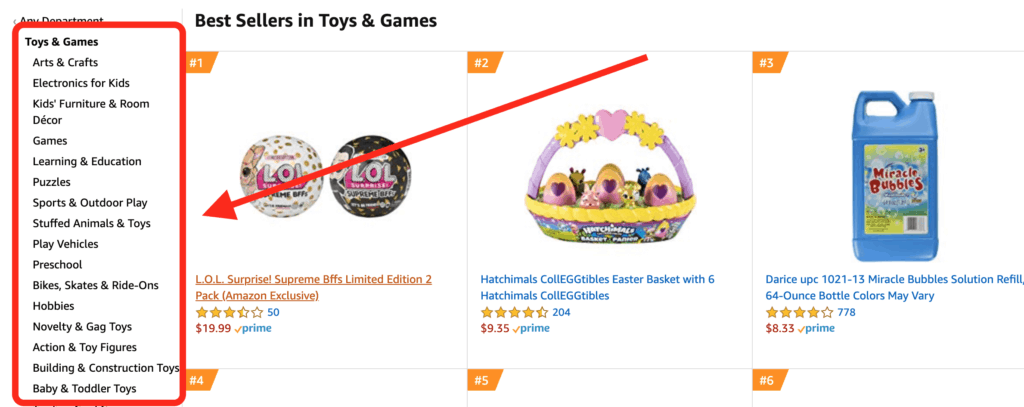
Doing this can be useful if you are just trying to get an idea of what is selling well on Amazon, but in most sourcing situations you will need to determine the sales rank for a specific product. You can find the sales rank of any product directly on the product detail page on Amazon’s website.
For example, here’s a screenshot of the sales rank for the board game Monopoly:
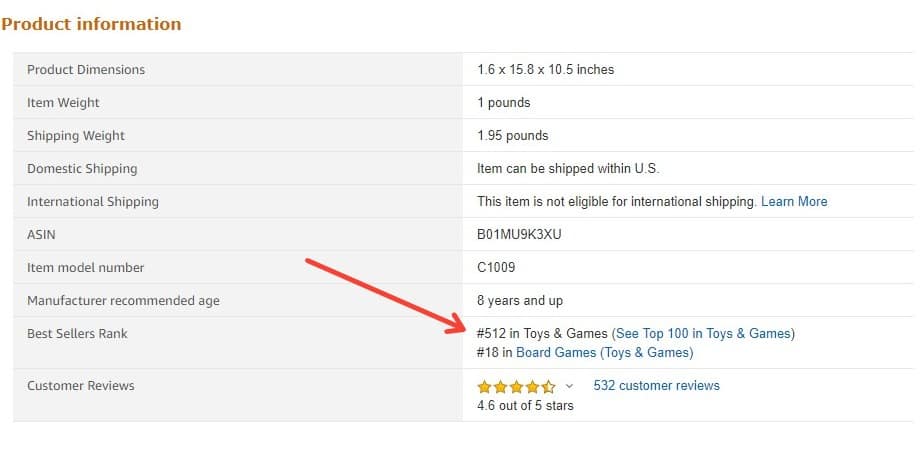
Source
This information is located in the “product information” section which is located part way down the page on any item you are looking at on Amazon. You can see at the time of this screenshot that this item has a sales rank of 512 in the Toys & Games category. This means that item is selling very quickly.
At the time you are reading this, the sales rank has likely changed. If you’d like to check, you can do so on the Monopoly product detail page.
This is just one way to find the sales rank of a product on Amazon. There are a variety of tools that will help you find the sales rank of an item based on the sourcing method that you are using. The majority of the tools I use display the sales rank of items in an easy to use format. You can see a full list of the tools I use in my online retail business on this page.
How to Use Sales Rank on Amazon
In this section, we’re going to go over the ways that I use sales rank in my business and how you can use it in yours.
But before we do that, I want to go over some things that you need to know before you can use sales rank effectively in your business. There are some common mistakes that people make because they don’t understand the potential pitfalls of relying on sales rank, and I don’t want you to find yourself in the same boat.
Avoid Costly Mistakes: Make Sure You Understand These Limitations Before Using Sales Rank
The first thing I want to make clear up front is something that anyone who has been selling on Amazon for a while can tell you.
You might have heard, “past performance does not guarantee future results” in other areas of your life, and this statement definitely applies to sales rank.
Sales rank does not guarantee how quickly the item will sell in the future, or even if the item will sell at all. But it does provide an indication of how it will sell in the future.
Sales Rank is not a static number
Another very important thing to keep in mind about sales rank is that it is constantly changing on most items. It is not a static number. For example, an item might have a sales rank of 14,000 on Monday, and a sales rank of 36,000 on Wednesday.
Seasonal items are a very common example where major shifts in sales rank occur. For example, many pumpkin-flavored products have sales ranks of well over 100,000 most months except for around Thanksgiving. Leading up to Thanksgiving these same items will have a sales rank of 1,000 or less. This is due to how many units are selling at different times of the year in relation to how other items in the category are selling.
Another example is the Hatchimals Easter Basket we discussed earlier. I am writing this on the Monday after Easter. If you walked into many retail stores today, you could probably find that item on clearance. If you scanned it, you would see it is currently the #2 item in the entire Toys and Games category.
In this situation due to the time of year, the product will most likely experience a very steep decline in sales. As a result the sales rank will increase due to fewer sales occurring.
There are some tools to help see sales rank fluctuations over time, and I’ll share more about those later in this post.
Sales Rank is Category Specific
It’s important to understand that the sales rank number is specific to items in the same category. This means that you need to have some knowledge about each category to fully understand how quickly an item is selling.
For example, an item with a rank of 500,000 in the books category is very likely selling at a significantly different pace than an item with a rank of 500,000 in the video games category.
This also means that there is an item in every category that has a sales rank of 1. All of these items that have a sales rank of 1 are selling at different rates.
The main takeaway is that when looking at sales rank you must also look at the category to use it effectively.
Now we have a pretty good understanding that sales rank is not perfect when it comes to predicting future sales. But it remains one of the best pieces of information that is available in relation to the demand of products for sale on Amazon.
As long as you are aware of the limitations of sales rank, you can use it as a tool when making your decisions about what items to source to sell on Amazon.
How We Use Sales Rank In Our Business (+ How You Can Too)
In my business, we use sales rank to help us make our decisions of what inventory to purchase to sell on Amazon. Sales rank factors in when we are sourcing via retail arbitrage, online arbitrage, or wholesale. If you aren’t familiar with any of these sourcing methods, those links go to free in-depth guides on all 3 that will help you get started.
When we are deciding whether or not to buy an item, we will look at sales rank to help make the decision. We will look at what the sales rank currently is, and what the sales rank has been in the past. We are able to see what it was previously on most items by using price and sales rank history charts. The main two tools we use for sales rank history charts are Keepa and CamelCamelCamel. Both display price history charts for free. If you want sales rank history charts these are only available to paid subscribers of Keepa, which costs about $17/month. With the paid version you will get access to sales rank history charts that look like this:

We have set up our buying guidelines to factor in sales rank to help us only buy items that have a very high likelihood of selling within about 3 months of being purchased. We’ve tweaked and adjusted how we factor sales rank into our buying guidelines over time as the business has evolved.
I recommend that you do the same in your business. One of the best ways to find out how fast items are selling with different sales ranks is to buy a variety of items. Buy items at a variety of ranges of sales rank, and over time you will be able to use sales rank to help gauge if an item will sell in your desired timeline.
What is a good sales rank?
Because of the vast number of items on Amazon, items with very large sales rank numbers can still sell very well. Like we discussed above, a “good sales rank” is also highly dependent on the category.
To give you a starting point, in the vast majority of categories, we prefer to buy items that have a sales rank with a number lower than 250,000. You can try using that as a starting point, and then refine it over time based on your own results.
I do not share the full buying guidelines we use for sourcing publicly. If you are interested in learning them, they are available as part of this course on retail arbitrage. If you enroll, you will get access to the exact guidelines I give to my employees for sourcing.
Conclusion
After reading this post hopefully you feel much more comfortable with what sales rank is and how to use it.
As long as you are aware of some of the pitfalls of sales rank, you can use it very effectively to help you make decisions. If you have any questions, please ask them in the comments section below!

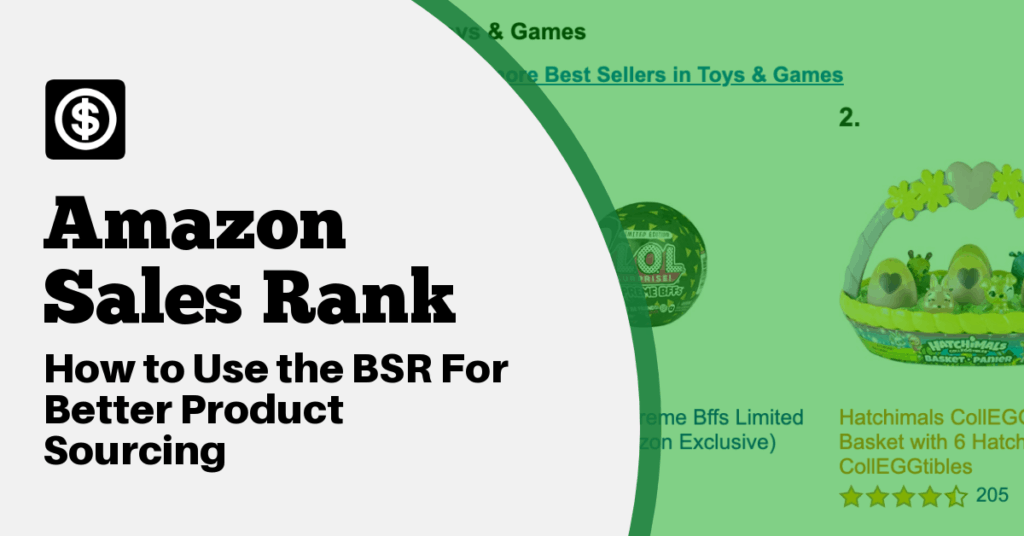
On occasion I have found products that do not have a ranking even they are in the Amazon catalog. Is it worth inventing in these products?
Hi Joanne,
Thanks for the comment, and this is a good question. In general products that do not have a rank have not sold on Amazon. There are exceptions to this, but that’s generally how things work. However, it does not mean that the product will not sell in the future.
Every product at one point or another did not have a sales rank, as it had to be listed first before sales could come in.
Now as to whether or not it’s worth investing in a product without a sales rank displaying, that depends a bit on the product. Is the product from a brand that many other products are selling well? Was the listing just created? Do you have a very high potential ROI on the product? If the answer to those questions is yes, then it’s likely worth purchasing.
If the answer is no, then it’s likely that it’s not worth the risk.
There’s no cut and dry way to say if a product will or won’t sell if it doesn’t have a sales rank, but that’s how we look at it in my business. Hope that helps a bit!
Best Regards,
Ryan